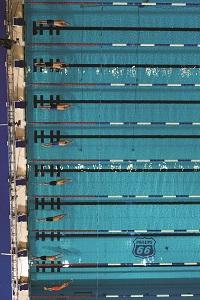

The amount of bids USA Synchronized Swimming receives to host its national championships, for example, goes up every year, according to Kevin Warner, chief operations officer of the Indianapolis-based national governing body. “Many facilities now ask for synchronized swimming requirements in the design stage,” he says, adding that the requirements to host national championships call for a designated area of the pool’s performance space to be deeper than nine feet.
Not all natatoriums are equipped to handle all types of aquatic events, though. Take water polo, which also has specific needs that include at least a depth of six feet in the field of play — although many smaller, nonstandard water polo courses are in use across the United States. “If I could build the perfect pool, seven feet would be the depth throughout,” says Claudia Dodson, director of club and member programs at USA Water Polo in Huntington Beach, California.

Aquatics Challenges
In addition to the depth requirements, officials at national governing bodies, as well as event planners and facility operators, must ensure that the proper equipment, timing and scoring systems, audio components and volunteers — lots of volunteers — are in place to pull off a successful competition.
Many pieces of equipment can be rented or donated, including bleachers, water polo goals and shot clocks, scoreboards and AV gear. But it’s difficult to rent additional water space, so a second pool, to be used specifically for warm-ups and cool-downs, has become almost essential.

Two of the less obvious but more serious challenges facing natatoriums are indoor air-quality control and insufficient Internet access. “Most facilities were never designed to hold a large number of swimmers for multiple days,” says Dean Ekeren, events and marketing director for Colorado Springs, Colo.-based USA Swimming, referring to poor ventilation systems that can result in burning eyes and coughing among both athletes and fans. “Most pool architects don’t think enough about that.”
To combat the issue, he suggests looking for facilities that have added, or would be willing to add, ventilation systems at or near the deck surface, to supplement existing ventilation. The extra vents will help pull and remove chemical vapors from the pool before they rise and begin circulating throughout the facility. Allowing as much fresh air as possible into the swimming area during session breaks, as well as before and after a day of competition, also will provide short-term improvements.

Renting bandwidth can be expensive, but it’s often necessary. “It’s one of the last things you’d normally think of when you’re building a swimming pool,” Ekeren says. “But once you have it temporarily, people start to rely on it, and then if you don’t have it, you’ll get pummeled.”
“The aquatics industry is tough,” admits Richard Sanders, vice president of sports marketing and special events for the Panama City Beach (Florida) Convention & Visitors Bureau, home of the eight-year-old Panama City Beach Aquatic Center, where a 50-meter pool will host the USA Synchronized Swimming Masters National Championships for the first time in October. “Aquatic centers in other cities have closed. Ours was not built for competition; it is a community pool first.”
Therein lies the challenge for facility operators caught between providing solid local programming and welcoming larger regional and national events.
 USA Swimming’s Ekeren admits that while designing and building for large-scale events benefits the growth of aquatics and boosts the economies of local communities, he suggests that shouldn’t be the main motivation. “Don’t build your venue specifically to accommodate a national championship,” he says. “Build it to fit your needs but leave space available so every four or five years, you can build it out and bring in more events. We’ve evolved to the point where we can go into a fairly bare-bones facility and build it out with spectator or athlete seating and other things, if the facility has the space.”
USA Swimming’s Ekeren admits that while designing and building for large-scale events benefits the growth of aquatics and boosts the economies of local communities, he suggests that shouldn’t be the main motivation. “Don’t build your venue specifically to accommodate a national championship,” he says. “Build it to fit your needs but leave space available so every four or five years, you can build it out and bring in more events. We’ve evolved to the point where we can go into a fairly bare-bones facility and build it out with spectator or athlete seating and other things, if the facility has the space.”
The other NGBs in aquatics have made similar accommodations, and as a result, water polo and synchronized swimming events are being hosted at first-time facilities in 2014. For such venues, those sports offer an opportunity to host elite competition on a smaller scale than a national USA Swimming or USA Diving event.
“We’re just trying to expand our horizons past baseball and basketball to sports that are not as traditional,” says Scott Harrison, director of sports for the Lubbock (Texas) Convention and Visitors Bureau. The Pete Ragus Aquatic Center, owned and operated by the Lubbock Independent School District, originally opened in 1997 and has since undergone two renovations, hosting the USA Diving Spring Junior West National Championships in 2011. Harrison adds that the CVB and school district are working together to attract a synchronized swimming event to Lubbock. “Whatever level we can get, we’ll take,” he says.

You’ll hear and see that kind of enthusiasm when you talk to other CVB sports directors, too.
“In aquatics, everybody is so passionate about what they do,” says Angel Natal, director of sports at the Metropolitan Tucson Convention & Visitors Bureau, which promotes the town of Oro Valley (Arizona.), located north of Tucson. “There are so many things we can do in this town related to aquatics.”
The Oro Valley Aquatic Center, anchored by a 50-meter competition pool with a stunning mountain backdrop and space to temporarily expand spectator seating beyond its usual capacity of 500 provided by fixed bleachers, will host the USA Synchronized Swimming National Championships, April 8-12. Meanwhile, the University of Arizona’s Hillenbrand Aquatic Center, a world-class water polo facility that can expand from seating for 600 to 1,000, welcomed the 2013 Union Americana de Natacion Junior Pan American Championships.

Eight hours northwest of Pearland, Lubbock has been drawing local high school, regional and national swimming and diving competitions to the Pete Ragus Aquatic Center. With two three-meter and three one-meter springboards, seating for 300 plus room to temporarily double that to 600, and recent scoreboard, timing system and touchpad upgrades, the facility is on an upward trajectory in terms of building a solid reputation for hosting high-profile aquatics events. Harrison gives credit to the partnering capabilities of the CVB, the Lubbock ISD and the high school coaches who make the bid presentations. “The relationship we have with that facility is crucial,” he says. “If we didn’t have that kind of close relationship, we’d be dead in the water promoting aquatics in Lubbock.”

Situated amid 200 acres of recreation space in Frank Brown Park (the competition pool abuts one of 11 baseball fields), the aquatic center opened in 2006 and has been overworked ever since. According to Sanders, there’s been talk of adding another 25-yard or 25-meter pool plus a warm-up pool in a proposed second recreation facility elsewhere in the community. “This is very important for serving the major swimming events,” he says. “A warm-up pool is something the current facility lacks, so we’re restricted on some of the events we can host.”

 The CrossPlex also includes a 200-meter hydraulically banked track and a 5,000-seat multipurpose arena, which collectively with the natatorium helped attract the NCAA Div. II National Championships Festival to Birmingham in March 2013 featuring men’s and women’s swimming and diving, men’s and women’s indoor track, and wrestling. The city has been awarded the same five-sport event in 2017. “We’ve got one of the top three indoor tracks in the nation, and when you add the pool, you’re not going to find anything else like the CrossPlex,” Galbaugh says. “We weren’t a big aquatics city before. But now we see there’s a real need out there for pools.”
The CrossPlex also includes a 200-meter hydraulically banked track and a 5,000-seat multipurpose arena, which collectively with the natatorium helped attract the NCAA Div. II National Championships Festival to Birmingham in March 2013 featuring men’s and women’s swimming and diving, men’s and women’s indoor track, and wrestling. The city has been awarded the same five-sport event in 2017. “We’ve got one of the top three indoor tracks in the nation, and when you add the pool, you’re not going to find anything else like the CrossPlex,” Galbaugh says. “We weren’t a big aquatics city before. But now we see there’s a real need out there for pools.”

